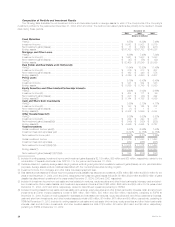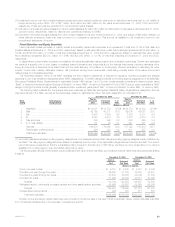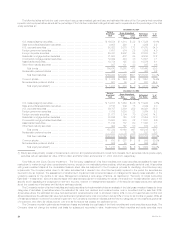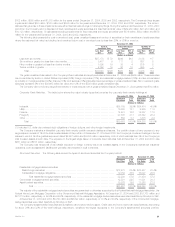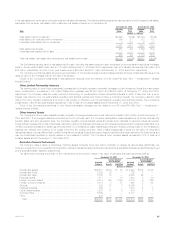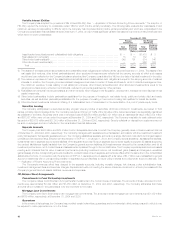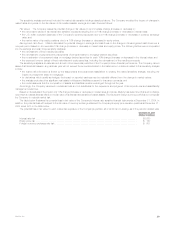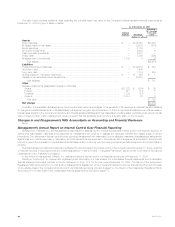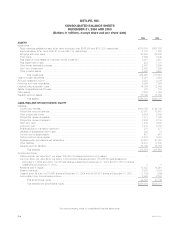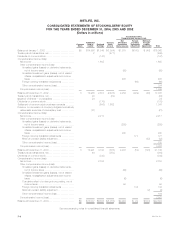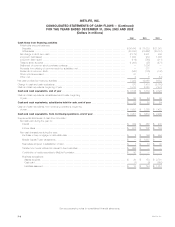MetLife 2004 Annual Report Download - page 41
Download and view the complete annual report
Please find page 41 of the 2004 MetLife annual report below. You can navigate through the pages in the report by either clicking on the pages listed below, or by using the keyword search tool below to find specific information within the annual report.MetLife also has a separate Corporate Risk Management Department, which is responsible for risk throughout MetLife and reports to MetLife’s Chief
Financial Officer. The Corporate Risk Management Department’s primary responsibilities consist of:
)implementing a board of directors-approved corporate risk framework, which outlines the Company’s approach for managing risk on an
enterprise-wide basis;
)developing policies and procedures for managing, measuring and monitoring those risks identified in the corporate risk framework;
)establishing appropriate corporate risk tolerance levels;
)deploying capital on an economic capital basis; and
)reporting on a periodic basis to the Governance Committee of the Holding Company’s Board of Directors and various financial and non-financial
senior management committees.
Asset/liability management. The Company actively manages its assets using an approach that balances quality, diversification, asset/liability
matching, liquidity and investment return. The goals of the investment process are to optimize, net of income taxes, risk-adjusted investment income and
risk-adjusted total return while ensuring that the assets and liabilities are managed on a cash flow and duration basis. The asset/liability management
process is the shared responsibility of the Portfolio Management Unit, the Business Finance Asset/Liability Management Unit, and the operating business
segments under the supervision of the various product line specific A/LM Committees. The A/LM Committees’ duties include reviewing and approving
target portfolios on a periodic basis, establishing investment guidelines and limits and providing oversight of the asset/liability management process. The
portfolio managers and asset sector specialists, who have responsibility on a day-to-day basis for risk management of their respective investing activities,
implement the goals and objectives established by the A/LM Committees.
Each of MetLife’s business segments has an asset/liability officer who works with portfolio managers in the investment department to monitor
investment, product pricing, hedge strategy and liability management issues. MetLife establishes target asset portfolios for each major insurance product,
which represent the investment strategies used to profitably fund its liabilities within acceptable levels of risk. These strategies include objectives for
effective duration, yield curve sensitivity, convexity, liquidity, asset sector concentration and credit quality.
To manage interest rate risk, the Company performs periodic projections of asset and liability cash flows to evaluate the potential sensitivity of its
securities investments and liabilities to interest rate movements. These projections involve evaluating the potential gain or loss on most of the Company’s
in-force business under various increasing and decreasing interest rate environments. New York State Department of Insurance regulations require that
MetLife perform some of these analyses annually as part of MetLife’s review of the sufficiency of its regulatory reserves. For several of its legal entities, the
Company maintains segmented operating and surplus asset portfolios for the purpose of asset/liability management and the allocation of investment
income to product lines. For each segment, invested assets greater than or equal to the GAAP liabilities less the DAC asset and any non-invested assets
allocated to the segment are maintained, with any excess swept to the surplus segment. The operating segments may reflect differences in legal entity,
statutory line of business and any product market characteristic which may drive a distinct investment strategy with respect to duration, liquidity or credit
quality of the invested assets. Certain smaller entities make use of unsegmented general accounts for which the investment strategy reflects the
aggregate characteristics of liabilities in those entities. The Company measures relative sensitivities of the value of its assets and liabilities to changes in
key assumptions utilizing Company models. These models reflect specific product characteristics and include assumptions based on current and
anticipated experience regarding lapse, mortality and interest crediting rates. In addition, these models include asset cash flow projections reflecting
interest payments, sinking fund payments, principal payments, bond calls, mortgage prepayments and defaults.
Common industry metrics, such as duration and convexity, are also used to measure the relative sensitivity of assets and liability values to changes
in interest rates. In computing the duration of liabilities, consideration is given to all policyholder guarantees and to how the Company intends to set
indeterminate policy elements such as interest credits or dividends. Each operating asset segment has a duration constraint based on the liability duration
and the investment objectives of that portfolio. Where a liability cash flow may exceed the maturity of available assets, as is the case with certain
retirement and non-medical health products, the Company may support such liabilities with equity investments or curve mismatch strategies.
Hedging activities. MetLife’s risk management strategies incorporate the use of various interest rate derivatives to adjust the overall duration and
cash flow profile of its invested asset portfolios to better match the duration and cash flow profile of its liabilities to reduce interest rate risk. Such
instruments include financial futures, financial forwards, interest rate and credit default swaps, caps, floors and options. MetLife also uses foreign
currency swaps and foreign currency forwards to hedge its foreign currency denominated fixed income investments. In 2004, MetLife initiated a hedging
strategy for certain equity price risks within its liabilities using equity futures and options.
Economic Capital. Beginning in 2003, the Company changed its methodology of allocating capital to its business segments from Risk-Based
Capital (‘‘RBC’’) to Economic Capital. Prior to 2003, the Company’s business segments’ allocated equity was primarily based on RBC, an internally
developed formula based on applying a multiple to the NAIC Statutory Risk-Based Capital and included certain adjustments in accordance with GAAP.
Economic Capital is an internally developed risk capital model, the purpose of which is to measure the risk in the business and to provide a basis upon
which capital is deployed. The Economic Capital model accounts for the unique and specific nature of the risks inherent in MetLife’s businesses. This is
in contrast to the standardized regulatory RBC formula, which is not as refined in its risk calculations with respect to the nuances of the Company’s
businesses.
This change in methodology is being applied prospectively. This change has and will continue to impact the level of net investment income and net
income of each of the Company’s business segments. A portion of net investment income is credited to the segments based on the level of allocated
equity. This change in methodology of allocating equity does not impact the Company’s consolidated net investment income or net income.
Risk Measurement; Sensitivity Analysis
The Company measures market risk related to its holdings of invested assets and other financial instruments, including certain market risk sensitive
insurance contracts, based on changes in interest rates, equity prices and currency exchange rates, utilizing a sensitivity analysis. This analysis estimates
the potential changes in fair value, cash flows and earnings based on a hypothetical 10% change (increase or decrease) in interest rates, equity prices
and currency exchange rates. The Company believes that a 10% change (increase or decrease) in these market rates and prices is reasonably possible
in the near-term. In performing this analysis, the Company used market rates at December 31, 2004 to re-price its invested assets and other financial
instruments. The sensitivity analysis separately calculated each of MetLife’s market risk exposures (interest rate, equity price and foreign currency
exchange rate) related to its non-trading invested assets and other financial instruments. The Company does not maintain a trading portfolio.
MetLife, Inc.
38


